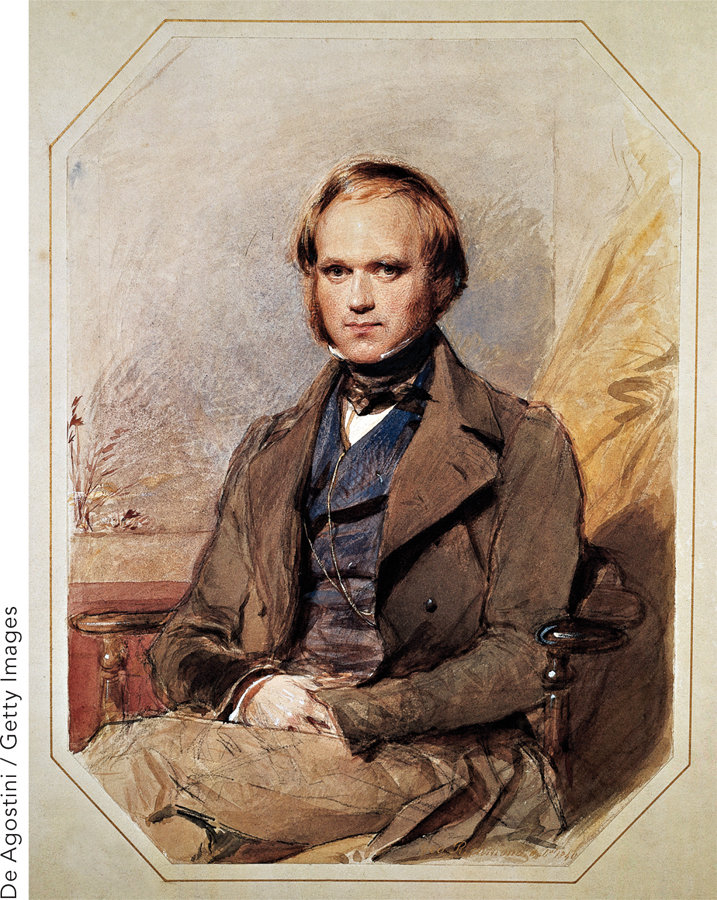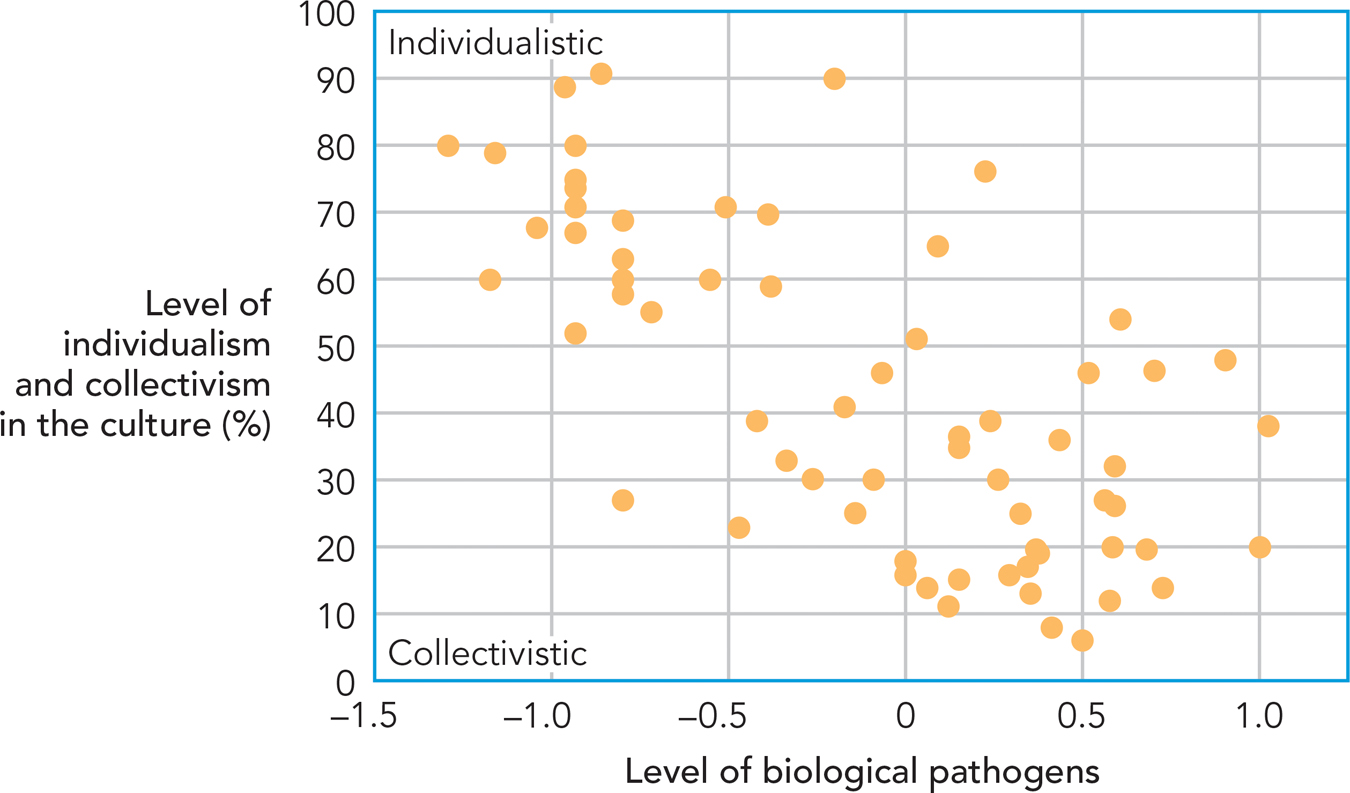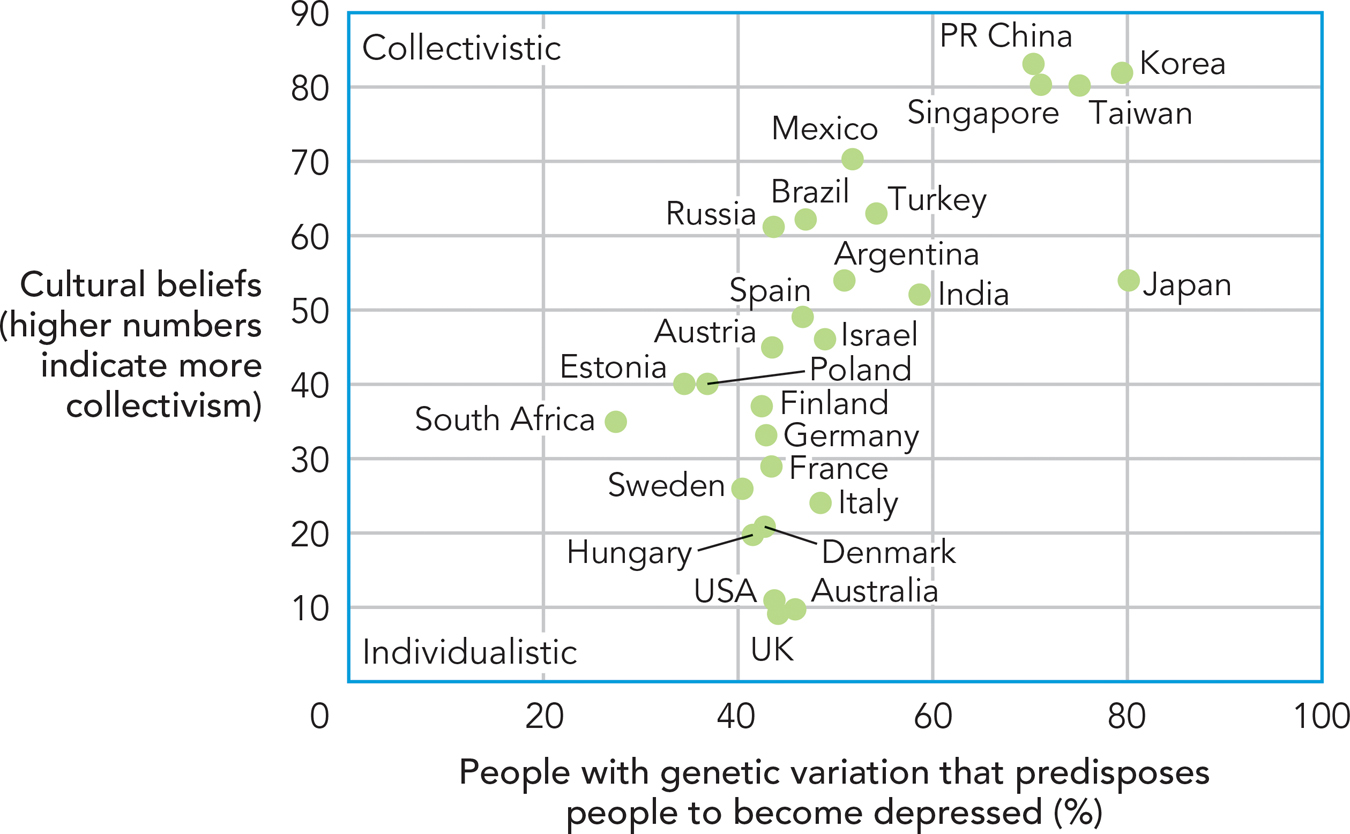4.4 Evolution and Psychology
From your perspective, the combining of genes from your mother and father at the moment of your conception is the start of a story. But from your genes’ perspective, it’s only the latest page in a story that began long ago. Your genes are the product of evolution, the biological process through which species develop and change across generations.
Let’s look at how evolution works. Then we’ll explore the implications of evolutionary processes for psychology.
Natural Selection
Preview Question
Question
 How do characteristics—
How do characteristics—
The great British biologist Charles Darwin had a simple idea. When it came to questions of evolution, Darwin said, Earth was like a giant, long-
Evolution on a contemporary farm differs in one main way from evolutionary processes that occurred on Earth millions of years ago. Back then, there were no farmers; no individuals intentionally selected organisms for breeding. Instead, nature—

As Darwin explained, in any naturally occurring environment some of an organism’s features are more adaptive than others—
When you examine evolved species in their natural habitats, it often seems as if they had been “designed” to fit the environment. However—
EVOLVED MECHANISMS. The long-
An example of a biological evolved mechanism is calluses (DeKay & Buss, 1992). Repeated friction on your hands or feet causes calluses to develop. You don’t have to learn to produce calluses; the callus-
Note, however, that this evolved mechanism does not, by itself, cause you to break out in calluses. If you lead a life of leisure, with no manual labor, your hands won’t have any calluses at all. Calluses only develop in a specific circumstance, namely, one in which you repeatedly experience friction on the skin. Thus, the observed characteristic (the callus) results from a combination of nature (the evolved mechanism) and nurture (the activity that causes the friction on the skin that activates the callus-
PROXIMAL AND DISTAL CAUSES. The example of calluses highlights another aspect of evolution-
The question “Why did you get that callus?” has two types of answers. One is proximal: Your skin cells reacted to friction on your skin. The other is distal: Across millions of years of primate evolution, organisms that could form calluses were better adapted to their environments, causing the callus-
WHAT DO YOU KNOW?…
Question 11
Explain why sweating is an evolved mechanism, making sure to note what problem we repeatedly faced in the past that it solved. Describe how sweating, like calluses, results from a combination of nature and nurture.

Evolutionary Psychology
Preview Questions
Question
 According to evolutionary psychologists, how did the mind evolve to produce our contemporary mental abilities, desires, and preferences?
According to evolutionary psychologists, how did the mind evolve to produce our contemporary mental abilities, desires, and preferences?
Question
 What are three limitations of evolutionary explanations of the modern mind?
What are three limitations of evolutionary explanations of the modern mind?
CONNECTING TO PROBLEM SOLVING AND PERSONALITY

Principles of evolution are important not only to biology, but also to psychology. Many of the problems faced in the evolutionary past were psychological in nature. To hunt animals or build shelters, people had to organize themselves into coordinated teams. To get help from others when sick or injured, they had to establish social bonds with the people who could provide the help. To reproduce, they had to attract mates. To avoid losing offspring, they needed to be effective parents. The ability to interact socially with others, therefore, was critical to survival and reproduction.
This suggests that evolutionary pressures shaped not only physical characteristics, but also mental ones. People with mental abilities that were adaptive—
This insight has given rise to a subfield of psychology known as evolutionary psychology, in which researchers explore the evolutionary foundations of contemporary human mental abilities, preferences, and desires (Buss, 1991; Caporeal, 2001).
All evolutionary psychologists agree that Darwinian natural selection produced the contemporary human mind that we possess today. But they do not all agree on the exact nature of that mind and the exact role of evolution in shaping it. Let’s now turn to two views of evolution and psychology. The first is the inherited mental modules perspective.
INHERITED MENTAL MODULES. One popular view is that, thanks to evolution, the human mind consists of numerous mental modules. A mental module is a subsystem of the mind and nervous system that performs a specific task in response to a specific type of environmental input (Fodor, 1983). The retina, at the back of the eye, is an example. It performs one task and one task only: responding to light that enters the eye. It won’t respond to sound. It can’t tell if it’s warm or cold. Because it is specialized to become active only in response to a specific type of input (light), it is considered modular. All psychologists agree that evolutionary processes created the modular mechanism that is the retina.
Some evolutionary psychologists propose that, over the course of evolution, the human mind acquired a large number of additional modules, each of which, like the retina, responds to a type of environmental input faced repeatedly by our evolutionary ancestors (Buss, 1991; Pinker, 1997). Consider a few examples throughout evolution:
People had to be effective parents. Thus, a module for parenting could have evolved.
People had to attract mates. Thus, a mate-
attraction module could have evolved. People had to avoid being cheated when exchanging goods (e.g., trading products in a marketplace). Thus, a cheating-
detection module could have evolved (Cosmides, 1989; also see Chapter 8).
The list could go on and on. There could be hundreds of such modules, each of which evolved hundreds of thousands of years ago.
TRY THIS!
Earlier, in our Try This! activity, you attempted to solve two kinds of problems. (If you didn’t, go to www.pmbpsychology.com and try them now.) You probably found one of them to be difficult—
Why was one problem easier than the other? In their basic structure, the problems were identical: They both presented a rule to be tested (“If a person has a D rating, then his documents must be marked Code 3”; “If a person is drinking beer, then he or she must be over 20 years old”) and four cards to turn over to see whether the rule was broken.
The psychologist Leda Cosmides (1989; Cosmides & Tooby, 2013) explains that the underage drinking problem was easy because of human’s evolved biological nature. Throughout evolution, people exchanged goods: food, drink, livestock, and so forth. The goods were necessary to survival, so it was important not to be cheated out of them. People who were able to detect cheating attempts were more likely to retain their goods, survive, and reproduce. Through natural selection, therefore, a mental module to detect cheating evolved. The underage drinking problem activated this mental module because it contained a case of potential cheating (underage drinking). The module, in turn, made problem solving easy.
The clerical problem, on the other hand, did not activate an evolved mental module. Over the course of evolution, our ancient ancestors did not spend any time filing documents; thus, there is no “document-

According to evolutionary psychologists, mental modules solve problems by producing preferences. Preferences that evolved in the evolutionary past shape your present likes and dislikes. For instance, why do you like pie, cake, and milkshakes when they can make you fat? During periods of evolutionary history when food was scarce, it was adaptive for humans to prefer high-
Does it give you comfort to know that your preference for high-
In this view, mental modules are specified in your genes (Lickliter & Honeycutt, 2003). Just as genes contain information to build body parts such as a heart and lungs, they contain information used to build neural systems that correspond to each mental module. These genetically specified mental modules are thought to be universal, that is, possessed in basically the same way by humans everywhere (Tooby & Cosmides, 2005). Just as people around the world have the same bodily organs, they have the same “mental organs” (Pinker, 1997).
This viewpoint makes a startling claim. Thoughts and preferences that you think you learned from modern society are, in reality, inherited—
When men evaluate the physical attractiveness of female figures, they rate “curvy” figures with a low waist-
THINK ABOUT IT
Evolutionary psychologists claim that contemporary humans have a “stone age mind” (Cosmides & Tooby, 1997) that was adapted to the environment experienced hundreds of thousands of years ago, when people hunted animals and gathered food growing in the wild. Today, we live in a very different environment of supermarkets, mass transit, smart phones. … Humans are handling this environment quite well; we have longer life phrases and higher standards of living than ever before (Morris, 2010). How come? If our minds really are adapted to a stone-
An evolutionary psychologist (Buss, 1989) found that men and women differed in their desires for a mate (i.e., a serious romantic partner). Women emphasized wealth; men’s financial resources, as reflected in job status or the ability to pay for dinner at a nice restaurant, were important to them. Men emphasized looks; they were attracted mostly to women’s physical attributes. Evolutionary psychology claims these preferences are not learned, but inherited (Buss, 1989). Throughout evolution, women have borne the physical burden of pregnancy. It was adaptive for them to seek men with status and resources, who could provide food and shelter during pregnancy and after childbirth. Men, in contrast, were free from the physical burdens of pregnancy and thus had less need for mates who could take care of them. Men’s preference for young, fit women also is said to have an evolutionary basis, because women who are young and fit are more likely to have a successful pregnancy (Buss, 1989). Men who preferred such women thus would have more offspring, and future generations of men would inherit the preference.
Does this sex difference in mate preferences characterize you and your friends?

THE INHERITED-
During almost every wait in the supermarket checkout line, I would find reference to the evolutionary psychology of human mating on the covers of … magazines. [In newspapers] I would often find articles … about the evolutionary psychology of mating, parent–
—Buller (2005, p. 3)
A main proponent of the mental-
Acclaim, however, does not imply correctness. In recent years, many scientists have questioned evolutionary psychologists’ claims (e.g., Heyes, 2012). No one doubts the significance of evolution to human behavior, yet the exact ways in which evolution did, or did not, shape contemporary humans’ abilities and preferences is a point of debate. Three factors raise questions about the inherited-
Subsequent research findings failed to confirm some original findings. Sometimes attractiveness is unrelated to waist-
to- hip ratio, in contrast to evolutionary- psychology explanations. Men’s judgments of attractiveness are more affected by women’s overall weight than by the ratio of waist size to hip size (Tassinary & Hansen, 1998). Sometimes men and women do not differ very much in their mate preferences. In nations where the gender difference in personal income is relatively small, the gender difference in mate preference is relatively small, too (Eagly & Wood, 1999). This implies that women may prefer men with wealth not merely because of factors in the evolutionary past but due to factors in the contemporary present: Being economically disadvantaged, they need more financial support. Page 145The mind cannot consist merely of mental modules. Even if the mind contains modules that solve specific problems, it has to contain more than just those modules (Dehaene & Naccache, 2001; Mithen, 1996). Suppose a single parent is deciding, one evening, whether to spend time with her child or call a babysitter to go on a date. Even if her mind contains a module devoted to dating problems and another module devoted to parenting problems, it must contain something more: a general-
purpose- thinking system that can combine information about parenting and dating, weigh one against the other, and make a decision. Researchers studying the mind recognize that mental modules are, at best, only a subset of the overall mechanisms of the mind (Dehaene & Naccache, 2001). Genes don’t, by themselves, determine the nature of an organism. This third point is one you’ve already learned. Organisms—
including people— develop through dynamic interactions between nature and nurture. Genetic information by itself does not produce an organism, as you saw in our coverage of epigenetics. Many scholars (e.g., Elman et al., 1996; Fodor & Piatelli- Palmarini, 2010; Lewontin, 2000; Lickliter & Honeycutt, 2013) question the inherited- modules hypothesis because it overestimates the role of inheritance and underestimates interactions between biology and the environment, that is, between nature and nurture.
These three limitations are significant, suggesting that an alternative perspective—

The second idea is one we have discussed earlier in this chapter, namely, that inheritance and experience combine to shape the brain and mind of the individual (Caporeal, 2001; Heyes, 2003, 2012). Increasingly, psychological scientists recognize that psychological abilities are not all “wired in” by evolution. Instead, they develop gradually as people interact with the environment (Karmiloff-
WHAT DO YOU KNOW?…
Question 12
True or False?
An example of a mental module is our preference for fatty foods.
A. B. Evolutionary psychologists assume mental modules are universal.
A. B. According to the text, in explaining behavior, a strength of the inherited-
modules perspective is that it carefully addresses the interactions between nature and nurture. A. B.
CULTURAL OPPORTUNITIES
Nature, Nurture, and Cultural Beliefs
The cultures of the world differ. Some differences, such as varying languages, clothing, and food, are obvious. Another variation, however, is more subtle: Cultures differ in their beliefs about the relation between individuals and society. Individualistic cultures promote the importance of individual rights. They value the needs of the individual over those of society and allow people to express themselves freely, even if their self-
Where do these cultural variations come from? Is it just random chance that some parts of the world end up with individualistic cultures and others are collectivistic, or is there a systematic cause?
Evidence indicates that cultural variations in individualism–
One example of culture adapting to biology involves pathogens (germs that make people sick). Some cultural practices shield people against pathogens and illness. In particular, collectivist cultures prompt people to bond closely with their own group and avoid contact with outsiders, thereby avoiding foreign germs (Fincher et al., 2008). This suggests an interesting hypothesis: Groups that encounter higher levels of biological pathogens should be more likely to adopt collectivistic cultural practices, to protect themselves from the germs. Correlational research confirms the hypothesis. When measures are taken in different parts of the globe, regions with higher levels of biological pathogens are found to have higher levels of collectivist beliefs (Figure 4.9; Fincher et al., 2008).

A second example of biology shaping culture involves depression. Collectivist cultures promote social harmony—

This research shows how biology could shape culture. But the route from biology to culture is a two-
In the research, investigators measured genetic diversity, the degree of variation in the genome among members of a given population, within each of three cultural groups in the Caucasus. Because all three groups had been living, for generation upon generation, in the same general area of the world, you might expect them to have roughly the same degree of genetic diversity. But, instead, one group displayed much less genetic variability than the others. Why? The cause was culture. Historically, the group with less genetic diversity had adopted two distinctive cultural practices: (1) Group members were encouraged to marry only members of their own local group; and (2) married couples lived with the husband’s parents, which reduces people’s tendency to stray from home. Thanks to these cultural practices, this group had less social contact, and thus less sexual mixing, with the various immigrant groups that had passed through their area of the world. As a result, they are less genetically diverse today (Marchani et al., 2008).
The lesson from the Caucasus is that not only do genes contribute to variations in culture, but culture contributes to variation in the human genome.
WHAT DO YOU KNOW?…
Question 13
How can an increase in pathogens shape collectivist cultural practices?
Nature, Nurture, and Diversity: The Case of Sexual Orientation
Preview Questions
Question
 Can evolutionary theory explain homosexuality?
Can evolutionary theory explain homosexuality?
Question
 What does research suggest concerning the genetic basis of homosexuality?
What does research suggest concerning the genetic basis of homosexuality?
In the course of evolution, the “bottom-
But that’s not what happened. Instead, people exhibit different sexual orientations, the primary form of a person’s sexual and romantic attraction. People with a heterosexual orientation are attracted to members of the opposite sex, those with a homosexual orientation are attracted to members of their same sex, and bisexual individuals are attracted to both men and women.
This three-
Surveys (e.g., Kinsey, Pomeroy, & Martin, 1948) provide estimates of how common the different sexual orientations are. It’s difficult to specify precise numbers, however, because survey responses vary depending on the exact question asked. In surveys in the United States and the United Kingdom, about 1.5% of men reported same-
EVOLUTION AND SEXUAL ORIENTATION. Although these numbers may sound small, in some ways they are big. If the 6% estimate is correct for the world at large, then nearly 300 million people have engaged in same-
This big number raises a big challenge for evolutionary theory. Homosexual orientation impairs reproduction because, of course, heterosexual pairing is the only way to reproduce. Because people who are exclusively homosexual do not leave behind offspring, you might expect that evolution would have eliminated homosexual preferences from our species. But that hasn’t happened, as nearly 300 million people could attest. How, then, can evolutionary theory explain the existence of homosexual orientation?
Scholars have suggested a range of answers to this question (Bailey & Zuk, 2009). One interesting possibility is that some genes have different effects in men and women. In men, they increase the likelihood of homosexuality. In women, the same genes increase the likelihood of childbirth; that is, they boost women’s biological capacity to have offspring. Initial evidence supporting this possibility came from a study in Italy (Camperio-
This result can explain how homosexuality may have evolved. The explanation is that homosexuality per se did not evolve. Instead, what evolved is a particular gene that, for human reproduction, has both benefits and costs. The benefit is that it increases childbearing among many women; the cost is that it reduces reproduction among some men (those who are homosexual). In the course of evolution, the benefits outweighed the costs.

GENETICS AND INDIVIDUAL DIFFERENCES IN SEXUAL ORIENTATION. Another source of evidence about the roots of sexual orientation is one discussed earlier in this chapter: twin studies. Researchers compare MZ to DZ twins to determine whether genetic factors contribute to individual differences in sexual orientation.
You learned earlier that genetics influences a wide range of psychological tendencies. Sexual orientation is no exception. MZ twin pairs are more similar in sexual orientation than are DZ twin pairs. In one study that focused on twins and homosexuality, researchers recruited homosexual research participants who had a twin and then determined the sexual orientation of the other member of the twin pair. Among women, 48% of MZ co-
A study of thousands of twins in Sweden similarly indicated a role for genetics (Långström et al., 2010). By comparing MZ to DZ twins, researchers found that genetics explains slightly more than one-
Genetic effects thus are significant to sexual orientation. But one-
Is this information about homosexuality consistent with your opinions and beliefs?
PRENATAL ENVIRONMENT AND SEXUAL ORIENTATION. When people discuss nature and nurture, they usually compare genetic influences (nature) to environmental influences that people experience after they are born (nurture). There’s something else to consider, though: the prenatal environment, that is, the biological environment experienced before a person is born. Findings indicate that prenatal factors influence sexual orientation.
One clue to this influence is that men with larger numbers of older brothers are more likely to be homosexual. Each older brother increases the odds of homosexuality by about 33% (e.g., a .06 chance would rise to .08; Dawood et al., 2009). You might expect the increase to be caused by nurture, not nature; maybe spending time with older male siblings increases attraction to males. But research reveals something else: an impact of the prenatal environment. Key evidence comes from studies of adopted children (Bogaert, 2006). To see their value to research, imagine two types of male children who experience the following environments:
No biological older siblings, but adopted into a household with older siblings
One or more older biological brothers, but adopted and not raised with them
Findings show that children of the second, but not the first, type are more likely to be homosexual. Having older siblings increases rates of homosexuality even if siblings are not raised together (Bogaert, 2006). How can this be? One explanation is maternal immune response (Bogaert, 2006). The maternal, female immune system recognizes a male child as biologically “foreign” and produces antibodies. With more male children, there are more antibodies, which may affect fetal brain development in a way that influences sexual orientation.
Additional evidence that the prenatal environment influences sexual orientation comes from an unlikely source: finger length. The link between finger length and sexual orientation involves hormones called androgens (hormones are biochemicals that travel through the body and influence bodily organs; see Chapter 3). In the prenatal environment, androgens stimulate the development of male sexual characteristics and also affect the development of the hand (Hines, 2010). Men and women thus differ in relative finger length as follows:
Among men, the fourth digit of the hand (the ring finger) tends to be longer than the second digit (the index or pointer finger); in other words, men’s 2D:4D ratio—the length of the second digit divided by that of the fourth digit—
tends to be low. Among women, whose androgen levels are lower, the second digit tends to be as long as or longer than the fourth; women tend to have a high 2D:4D ratio (Figure 4.11).

The effect of androgens on both sexual characteristics and finger length leads to an interesting hypothesis: 2D:4D ratio may predict sexual orientation. To test it, researchers conducted a meta-
WHAT DO YOU KNOW?…
Question 14
True or False?
The gene that increases the probability of childbearing in women may increase the likelihood of homosexuality in men.
Twin studies suggest that genes account for a majority of the overall variability in sexual orientation.
Men who have a large number of older brothers are more likely to be homosexual.
Research suggests that maternal immune response, a feature of the prenatal environment, may play a role in shaping sexual orientation.
The gene that increases the probability of childbearing in women may increase the likelihood of homosexuality in men.
A. B. Twin studies suggest that genes account for a majority of the overall variability in sexual orientation.
A. B. Men who have a large number of older brothers are more likely to be homosexual.
A. B. Research suggests that maternal immune response, a feature of the prenatal environment, may play a role in shaping sexual orientation.
A. B.